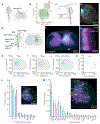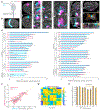Topographical and cell type-specific connectivity of rostral and caudal forelimb corticospinal neuron populations
- PMID: 38551963
- PMCID: PMC11100358
- DOI: 10.1016/j.celrep.2024.113993
Topographical and cell type-specific connectivity of rostral and caudal forelimb corticospinal neuron populations
Abstract
Corticospinal neurons (CSNs) synapse directly on spinal neurons, a diverse assortment of cells with unique structural and functional properties necessary for body movements. CSNs modulating forelimb behavior fractionate into caudal forelimb area (CFA) and rostral forelimb area (RFA) motor cortical populations. Despite their prominence, the full diversity of spinal neurons targeted by CFA and RFA CSNs is uncharted. Here, we use anatomical and RNA sequencing methods to show that CSNs synapse onto a remarkably selective group of spinal cell types, favoring inhibitory populations that regulate motoneuron activity and gate sensory feedback. CFA and RFA CSNs target similar spinal neuron types, with notable exceptions that suggest that these populations differ in how they influence behavior. Finally, axon collaterals of CFA and RFA CSNs target similar brain regions yet receive highly divergent inputs. These results detail the rules of CSN connectivity throughout the brain and spinal cord for two regions critical for forelimb behavior.
Keywords: AnteroT-seq; CFA; CP: Neuroscience; RFA; corticospinal; motor control; motor cortex; spinal cord; transneuronal.
Copyright © 2024 The Author(s). Published by Elsevier Inc. All rights reserved.
Conflict of interest statement
Declaration of interests The authors declare no competing interests.
Figures




Update of
-
Topographical and cell type-specific connectivity of rostral and caudal forelimb corticospinal neuron populations.bioRxiv [Preprint]. 2023 Nov 17:2023.11.17.567623. doi: 10.1101/2023.11.17.567623. bioRxiv. 2023. Update in: Cell Rep. 2024 Apr 23;43(4):113993. doi: 10.1016/j.celrep.2024.113993. PMID: 38014164 Free PMC article. Updated. Preprint.
Similar articles
-
Topographical and cell type-specific connectivity of rostral and caudal forelimb corticospinal neuron populations.bioRxiv [Preprint]. 2023 Nov 17:2023.11.17.567623. doi: 10.1101/2023.11.17.567623. bioRxiv. 2023. Update in: Cell Rep. 2024 Apr 23;43(4):113993. doi: 10.1016/j.celrep.2024.113993. PMID: 38014164 Free PMC article. Updated. Preprint.
-
Differential contributions of rostral and caudal frontal forelimb areas to compensatory process after neonatal hemidecortication in rats.Eur J Neurosci. 2011 Nov;34(9):1453-60. doi: 10.1111/j.1460-9568.2011.07866.x. Eur J Neurosci. 2011. PMID: 22034976
-
Multiple axon collaterals of single corticospinal axons in the cat spinal cord.J Neurophysiol. 1986 Mar;55(3):425-48. doi: 10.1152/jn.1986.55.3.425. J Neurophysiol. 1986. PMID: 3514812 Review.
-
Comparison of the connectional properties of the two forelimb areas of the rat sensorimotor cortex: support for the presence of a premotor or supplementary motor cortical area.Somatosens Mot Res. 1993;10(3):269-89. doi: 10.3109/08990229309028837. Somatosens Mot Res. 1993. PMID: 8237215
-
Adaptation in the spinal cord after stroke: Implications for restoring cortical control over the final common pathway.J Physiol. 2025 Feb;603(3):685-721. doi: 10.1113/JP285563. Epub 2024 May 24. J Physiol. 2025. PMID: 38787922 Review.
Cited by
-
The diversity and plasticity of descending motor pathways rewired after stroke and trauma in rodents.Front Neural Circuits. 2025 Mar 21;19:1566562. doi: 10.3389/fncir.2025.1566562. eCollection 2025. Front Neural Circuits. 2025. PMID: 40191711 Free PMC article. Review.
-
SpinalTRAQ: A novel volumetric cervical spinal cord atlas identifies the corticospinal tract synaptic projectome in healthy and post-stroke mice.bioRxiv [Preprint]. 2024 Oct 10:2024.08.23.609434. doi: 10.1101/2024.08.23.609434. bioRxiv. 2024. PMID: 39416130 Free PMC article. Preprint.
-
Corticospinal Tract Development, Evolution, and Skilled Movements.Mov Disord. 2025 Jul;40(7):1221-1232. doi: 10.1002/mds.30199. Epub 2025 Apr 25. Mov Disord. 2025. PMID: 40277091 Free PMC article. Review.
-
A brain-wide map of descending inputs onto spinal V1 interneurons.Neuron. 2025 Feb 19;113(4):524-538.e6. doi: 10.1016/j.neuron.2024.11.019. Epub 2024 Dec 23. Neuron. 2025. PMID: 39719703
-
Neuropathic Pain-Like Responses in a Chronic CNS Injury Model Are Mediated by Corticospinal-Targeted Spinal Interneurons.J Neurosci. 2025 Jul 16;45(29):e1264242025. doi: 10.1523/JNEUROSCI.1264-24.2025. J Neurosci. 2025. PMID: 40550694
References
Publication types
MeSH terms
Grants and funding
LinkOut - more resources
Full Text Sources
Molecular Biology Databases
Miscellaneous

